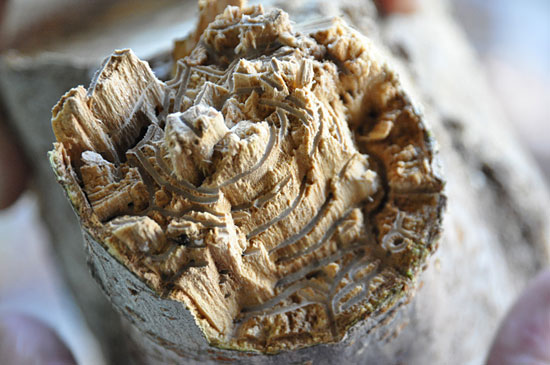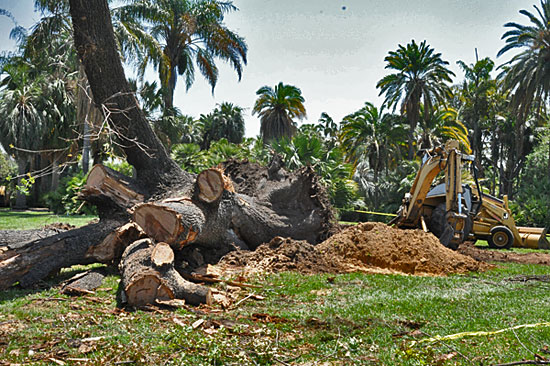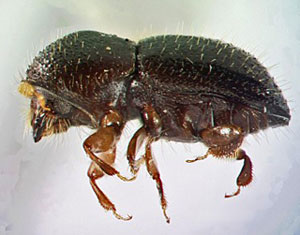Beetle mania hits SoCal trees
December 6, 2012

A box elder at Huntington Botanical Gardens shows damage from a voracious new beetle. Photo/Maxx Echt
No one is certain how it got here. The best guess is that it stowed away on a Southeast Asian shipping crate. The first local sighting appears to have been in 2003 at Whittier Narrows. By 2010, it was suspected of killing box elders in Long Beach.
By 2011, it had infested the first of hundreds of trees at the Los Angeles County Arboretum and Botanic Garden in Arcadia and the Huntington Botanical Gardens in San Marino. By the spring of 2012, alerts were being issued throughout the avocado industry.
Now, scientists are warning that a new species of beetle, tinier than a sesame seed but devastating as poison, has gained a foothold in Southern California, threatening scores of tree species, including the native California sycamore and the iconic coast live oak.
“This has been like something out of a science fiction novel,” says Tim Thibault, the Huntington’s curator of woody collections. Thibault says the bug initially was assumed to be an exotic pest called the “tea shot hole borer” that afflicts tea plants in Asia. But when it turned up on more than 100 species, killing some in less than two years, DNA tests revealed that both it and a lethal fungus it carries were new to science.
“It’s been named the polyphagous shot hole borer,” he says. “That’s because the word ‘polyphagous’ means it ‘eats everything’.”
“This is a very big issue for the county at large, and it needs to be coordinated at a high level,” says Brian Sullivan, director of horticulture at Descanso Gardens. “This bug isn’t worrying about what city it’s in.”
So far, scientists say, the new beetle has been found throughout Los Angeles and northern Orange Counties, as far south as Laguna Beach, as far north as Azusa, as far east as Pomona and as far west as Los Angeles International Airport, where it has infested a stand of coral trees.
Whether it has spread to wildlands such as the Santa Monica Mountains is as yet uncertain, but researchers are hoping a January 12 symposium at the Huntington for arborists, gardeners and homeowners will help track the infestation.
“We’re hoping we’ll get a bunch of people out there who’ll look at trees in their parks and neighborhoods and help serve as an early warning system,” says Rosi Dagit, senior biologist at the Santa Monica Mountains Resource Conservation District. (For more information on the symposium, organized by the RCD, the Huntington, the Los Angeles County Department of Agricultural Commissioner and the University of California Division of Agriculture and Natural Resources, click here.)
Akif Eskalen, a UC Riverside plant pathologist who has led the research into the new beetle, says that it probably has been hanging around Southern California for about a decade, unnoticed or misidentified. The discovery of even one new species, let alone two, is highly unlikely; Eskalen, a specialist at the UC Agriculture and Natural Resources/UC Cooperative Extension, says he stumbled on the new beetle and fungus “totally by chance” nine months ago when a desperate homeowner contacted him online for help with a backyard avocado tree that was mysteriously but rapidly dying.
Curious, Eskalen drove two hours to the woman’s home in South Gate. He says he could tell right away that the discolored wood, tiny round holes and powdery white spots were a sign of something unusual.
In his lab on the Riverside campus, he confirmed that the tree was under attack from a variety of the Fusarium fungus borne by so-called “ambrosia beetles,” a broad category of insects that burrow into trees and implant the fungus so that their larvae can feed on it as they develop.
“But ambrosia beetles usually attack plants that are dead or dying,” says Eskalen. “These were attacking bigger, well-watered plants.”
Israeli researchers had already reported that the beetle-fungus combo had severely damaged avocado groves there. Further detective work, by Eskalen and others, revealed that it had infested the weedy, poisonous castor bean shrubs that grow wild around Southern California’s riverbeds, orchards and freeways. Surveys at local arboreta and botanical gardens also showed, however, that the pest isn’t picky.
“We’ve lost two large English oaks, two box elders and a coast live oak,” says the Huntington’s Thibault. “And we have literally hundreds of trees infected—a lot of our native oaks, a lot of coast live oaks. A century-old Japanese maple and a wisteria original to the design of the Japanese Gardens.”
Also, he says, infected trees deteriorate swiftly: A strawberry tree that became a host in the spring of 2010 was dead by October 2011, he says.
One positive discovery is that some trees are less vulnerable than others; the main concern is for the 20 or so species of trees in which the beetles prefer to reproduce. Eskalen says the fungus, carried in the beetle’s mouth, is what kills the trees, and it spreads as the beetle burrows to lay eggs in the heartwood, attacking the plant’s vascular tissue and blocking the flow of water and nutrients.
The bad news, however, is that those vulnerable trees include more than half the street trees being used in California, and some of the most precious native varieties. Nor does the bug appear to be going away soon.
“It seems to have been waiting in the wings until just the right moment,” says Frank McDonough, botanical information consultant at the county Arboretum, noting that some scholarly studies have linked the evolution of ambrosia beetles to prehistoric periods of global warming.
And, says Gevork Arakelian, senior biologist for the Los Angeles County Agricultural Commissioner/Weights & Measures, so far there is no solution.
For now, the only thing homeowners can do is to use local firewood and chip and tarp infected trees on site to avoid spreading the pest or the fungus.
“It’s too late to talk about eradication,” says Arakelian. “We have to concentrate our efforts on introducing a potent biological control agent. This pest is here to stay.”

A century-old oak at the Huntington succumbed to the polyphagous shot hole borer and was removed in May. Photo/Maxx Echt
Posted 11/28/12













 405 bridge work causes a stink
405 bridge work causes a stink





